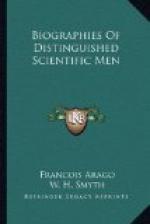Sir D. Brewster imagines that the non-luminous rays of caloric, which form a constituent part of the solar light, are emitted by the dark nucleus of the sun; whilst the visible coloured rays proceed from the luminous matter by which the nucleus is surrounded. “From thence,” he says, “proceeds the reason of light and heat always appearing in a state of combination: the one emanation cannot be obtained without the other. With this hypothesis we should explain naturally why it is hottest when there are most spots, because the heat of the nucleus would then reach us without having been weakened by the atmosphere that it usually has to traverse.” But it is far from being an ascertained fact, that we experience increased heat during the apparition of solar spots; the inverse phenomenon is more probably true.
Herschel occupied himself also with the physical constitution of the moon. In 1780, he sought to measure the height of our satellite’s mountains. The conclusion that he drew from his observations was, that few of the lunar mountains exceed 800 metres (or 2600 feet). More recent selenographic studies differ from this conclusion. There is reason to observe on this occasion how much the result surmised by Herschel differs from any tendency to the extraordinary or the gigantic, that has been so unjustly assigned as the characteristic of the illustrious astronomer.
At the close of 1787, Herschel presented a memoir to the Royal Society, the title of which must have made a strong impression on people’s imaginations. The author therein relates that on the 19th of April, 1787, he had observed in the non-illuminated part of the moon, that is, in the then dark portion, three volcanoes in a state of ignition. Two of these volcanoes appeared to be on the decline, the other appeared to be active. Such was then Herschel’s conviction of the reality of the phenomenon, that the next morning he wrote thus of his first observation: “The volcano burns with more violence than last night.” The real diameter of the volcanic light was 5000 metres (16,400 English feet). Its intensity appeared very superior to that of the nucleus of a comet then in apparition. The observer added: “The objects situated near the crater are feebly illuminated by the light that emanates from it.” Herschel concludes thus: “In short, this eruption very much resembles the one I witnessed on the 4th of May, 1783.”
How happens it, after such exact observations, that few astronomers now admit the existence of active volcanoes in the moon? I will explain this singularity in a few words.




